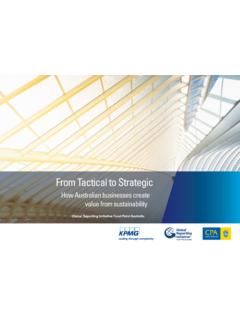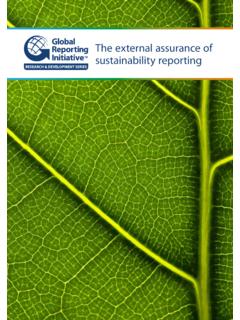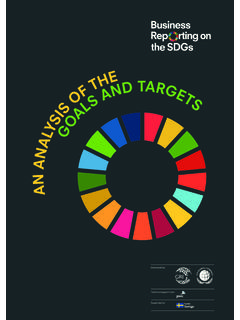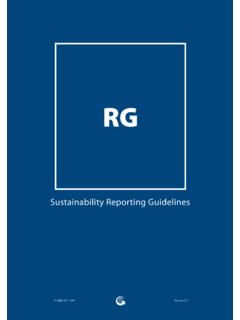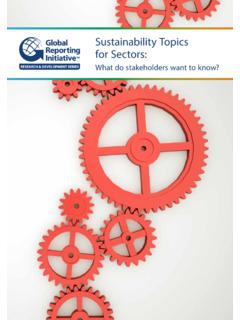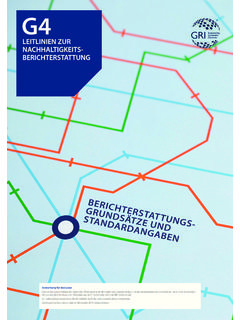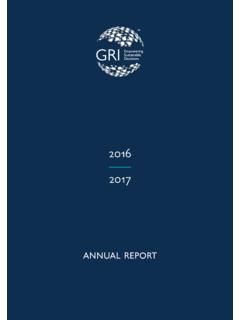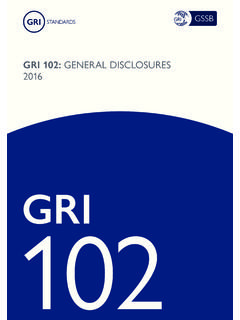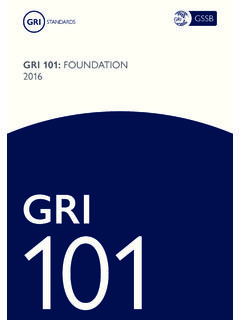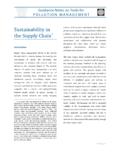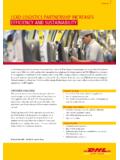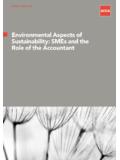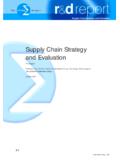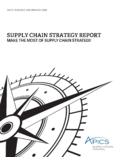Transcription of Small Business, Big Impact: SME Sustainability …
1 1 TITLE textSMALL BUSINESSBIG IMPACTSME Sustainability REPORTING FROM VISION TO ACTION 2 WHAT IS THE business case FOR Sustainability AND REPORTING? 3 THE GLOBAL Sustainability CONTEXT 4 THE UNITED NATIONS SUSTAINABLE DEVELOPMENT GOALS (SDGs) 5 HOW WILL THE SDGs IMPACT SMEs? 6 WHY ARE SMEs CRUCIAL TO ACHIEVING A SUSTAINABLE FUTURE? 7 What SMEs can do 7 WHAT IS Sustainability REPORTING AND HOW CAN IT HELP SMEs? 8 Sustainability Context 8 Stakeholder Inclusiveness 9 Materiality 9 Completeness 9 GETTING STARTED 11 TAKE ACTION 13 CONTENTSCOPYRIGHTThis document is copyright-protected by Stichting Global Reporting Initiative (GRI) and the International Organization of Employers (IOE).
2 The reproduction and distribution of this document for information is permitted without prior permission from GRI or IOE. However, neither this document nor any extract from it may be reproduced, stored, translated, or transferred in any form or by any means (electronic, mechanical, photocopies, recorded, or otherwise) for any other purpose without prior written permission from GRI or the GRI Board of Directors, the Stichting Global Reporting Initiative or the International Organization of Employers (IOE) can assume responsibility for any consequences or damages resulting, directly or indirectly, from the use of this publication. The findings and views expressed herein do not necessarily represent the views, decisions or the stated policy of GRI or IOE, nor does citing of trade names or commercial processes constitute DEVELOPMENTL inda Kromjong (IOE), Shivani Rajpal (GRI), Matthias Thorns (IOE), Rutger Verkouw (GRI).
3 With contributions from:Jack Boulter, Rania Dalalaki, Davion Ford (GRI).General SupervisionAsthildur Hjaltadottir (GRI)Text Revision and EditingLucy Goodchild van Hilten, Tell LucyDesign and LayoutMark Bakker, Scribble DesignPhotographyAll photography: 3 VISION & STRATEGY SMEs can set direction by placing their purpose, vision and strategy into the context of global Sustainability . The Sustainability reporting process helps to make this explicit to SYSTEMS Sustainability management and reporting requires management systems, which improve data quality. Tracking data highlights opportunities for improve-ment, e ciency and cost & WEAKNESSE arly warnings of emerging issues can help management seize opportunities or evaluate potentially damaging developments early, before they emerge as unwelcome surprises. EMPLOYEE MOTIVATIONE ngaging the workforce in Sustainability e orts reduces absenteeism, attracts new talent and increases productivity through a motivated workforce.
4 It is also a great way to upscale e BENEFITSEXTERNAL BENEFITSVALUE OF REPORTINGREPUTATION & TRUST Proactive and transparent communica-tion about your Sustainability e orts builds goodwill, reducing reputation risks. It also improves product image, brand name and CAPITAL Reducing risk through Sustainability management and communication can help signal quality and good management, providing potential for new sources of capital and lower ENGAGEMENTO ngoing learning from the outside-in. Stay up-to-date on the regulatory environment. Sustainability reporting is a powerful tool to build or restore trust among ADVANTAGEC ustomers are looking for suppliers that minimize environmental and social risks. By reporting, SMEs can increase customer satisfaction and loyalty, and access the supply IS THE business case FOR Sustainability AND REPORTING?
5 The business case for integrating Sustainability into operations has been well documented over the last 15 years. However, it is only through transparent reporting and communicating about your Sustainability work, performance and progress towards your goals that you can capture the value of Sustainability . Without communication, how could you build reputation and trust? And how could you attract new capital or build competitive advantage if you did not communicate with stakeholders? Reporting will help you unlock that value. Before starting the process it is important to gain a deeper understanding of Sustainability management and reporting by zooming out for a big picture about your answers to the following questions before looking at the Sustainability context. 4 Our world is changing at breakneck speed. One driving force is the rapid growth of the global population.
6 In 1950 there were fewer than 3 billion people; the United Nations (UN) expects the global population to grow to more than 9 billion in 2050, which means it will have more than tripled in just 100 years. This growing population increases demand for goods and services, which is good for business . However, the challenge for business and society is to meet this growing demand while the natural resources available to us are depleting. Today we use the equivalent of planets to provide the resources we use globally and to absorb our waste. This means it now takes the Earth more than 18 months to regenerate what we use in a This is at odds with the UN s definition of sustainable development: meeting the needs of the present without compromising the ability of future generations to meet their own needs. According to moderate UN predictions, we are on track to need two planets by the 2030s, which will have big implications for demand for goods and services grows exponentially over time, the supply of natural resources such as materials necessary to produce those goods and services decreases over time they are being consumed faster than they can be regenerated by natural systems.
7 What will happen in the long-term, when demand for natural resources consistently outruns their supply? To facilitate a practical approach to the global Sustainability challenge, 190 countries collaborated to design and launch the UN s Sustainable Development Goals (SDGs) in GLOBAL Sustainability CONTEXT1. will you contribute to building that future?What is your vision of the future, for your business and your community?How can we build a sustainable, equitable and responsible future?How will your organization operate in this new future?How can we foster well-being and meet the needs of more people in a world of limited resources?What are the largest Sustainability challenges in your country today? What will they be in 2030? 5 THE UNITED NATIONS SUSTAINABLE DEVELOPMENT GOALS (SDGs)The UN s Sustainable Development Goals (SDGs) were designed to help society and business to focus on solving global Sustainability challenges.
8 As a key stakeholder, the business sector was closely involved in the development process. The SDGs provide a vision of a sustainable future and propose actionable targets for today s major Sustainability challenges: climate change water scarcity food insecurity waste and pollution inequality human rights urbanizationAs such, the SDGs attempt to address the root causes of poverty and the universal need for development that works for all people. It is clear that the SDGs will only be achieved by engaging SMEs. In addition to global policy frameworks such as the SDGs, there is a growing trend for governments, stock exchanges and other regulators to translate global goals into laws, regulations and requirements for Sustainability and reporting on non-financial data, such as: EU Directive 2014/95/EU requires disclosure of non-financial and diversity information by certain large undertakings and groups in all EU Member States.
9 The Modern Slavery Act 2015 is an Act of the Parliament of the United Kingdom. It is designed to tackle slavery in the UK and consolidates previous offences relating to trafficking and slavery. The California Transparency Supply Chains Act (SB 657) addresses human trafficking and slavery in supply chains. The Johannesburg Stock Exchange (JSE) Listing Requirement, 2010, requires 450 South African companies listed on the JSE to produce an annual integrated report (financial and Sustainability information) or explain why they do not. The Securities and Exchange Board of India (SEBI), business Responsibility Reports, 2015, initially requires the country s top 500 companies to engage in a thorough environmental and social reporting process. 6 These regulations and requirements have clear implications for the business sector, especially large multinationals that depend on globalized supply chains.
10 The ripple effect ensures these regulations also impact SMEs all over the world that supply to multinationals, as they may be required to report environmental and social information to the multinational buyer. Overall, these developments drive increased stakeholder and societal demands for transparency and responsible business practices. How will the SDGs impact SMEs?Global policy drives national policy, which in turn drives local businesses to take action. (See diagram above: From global policy to local implications.)Having an integrated approach to supporting progress across the multiple interconnected SDGs is crucial to moving towards better outcomes. SMEs can use the goals and targets to assess their current operations by identifying, assessing and measuring how they contribute to or undermine each goal. From there the SDGs are useful in two ways: firstly, your organization can minimize, measure and report your impacts in relation to the SDGs and implement new ideas that improve your business , reducing your footprint and minimizing overall impacts.
